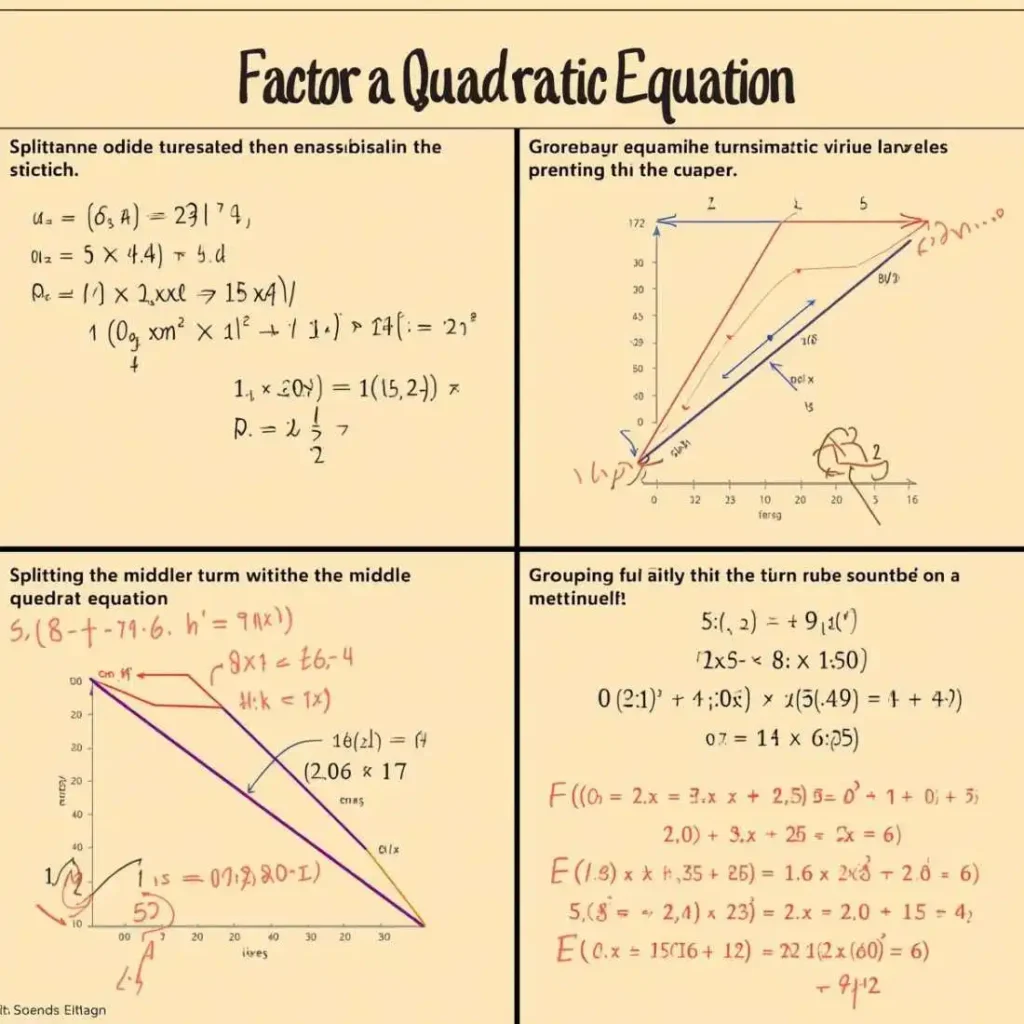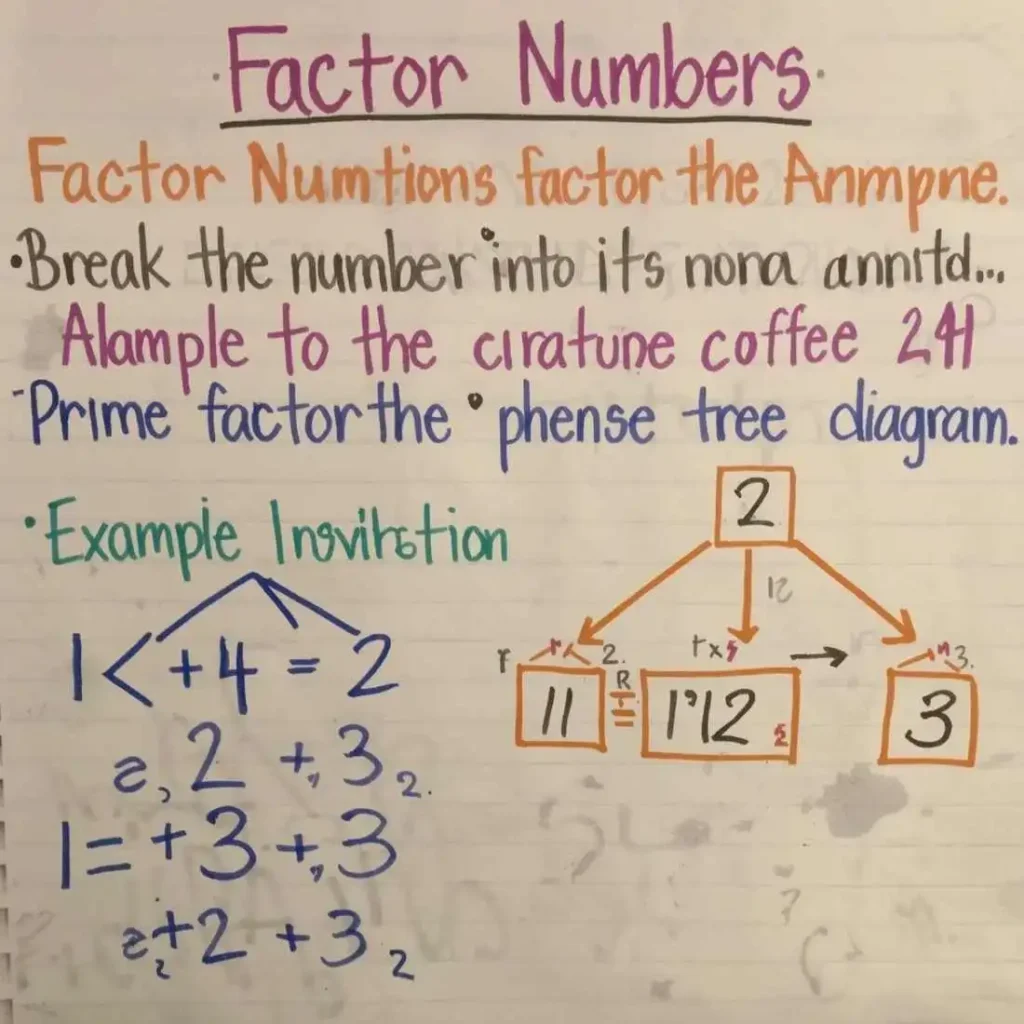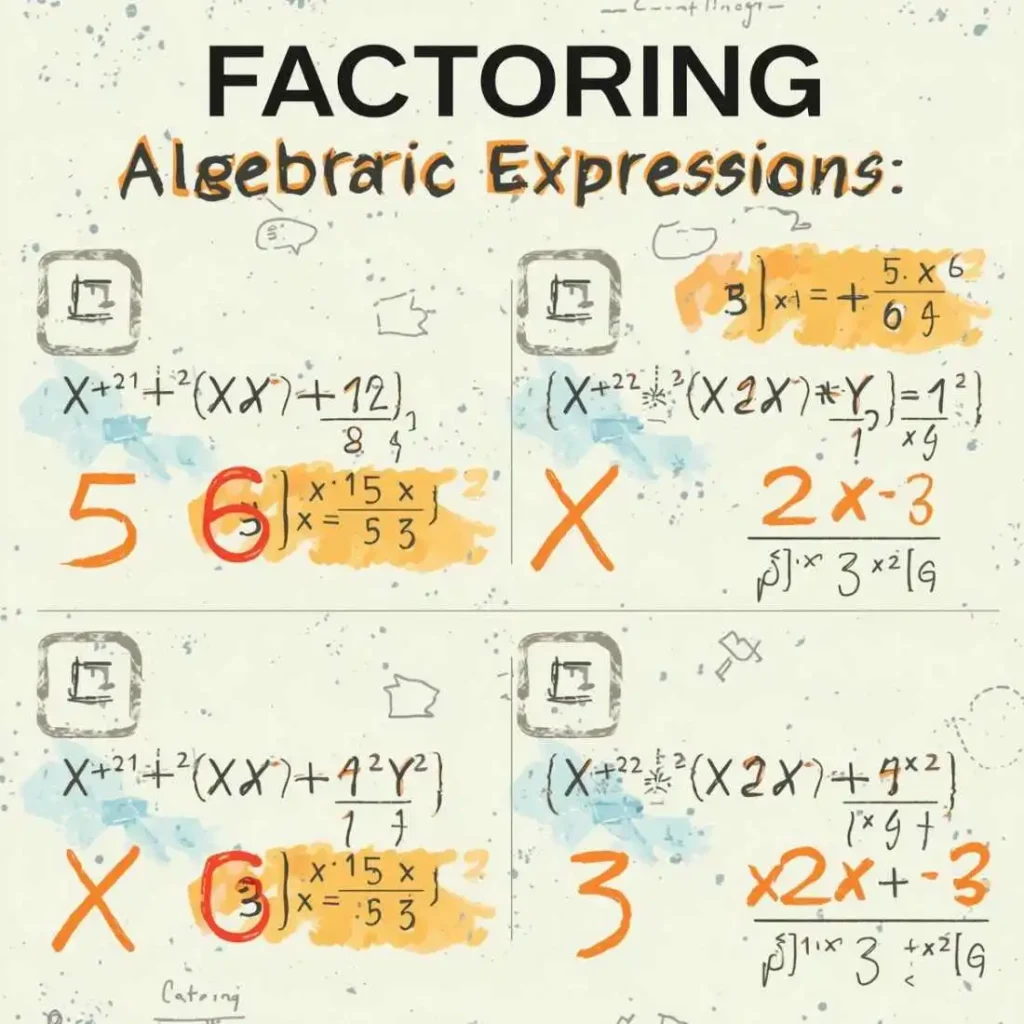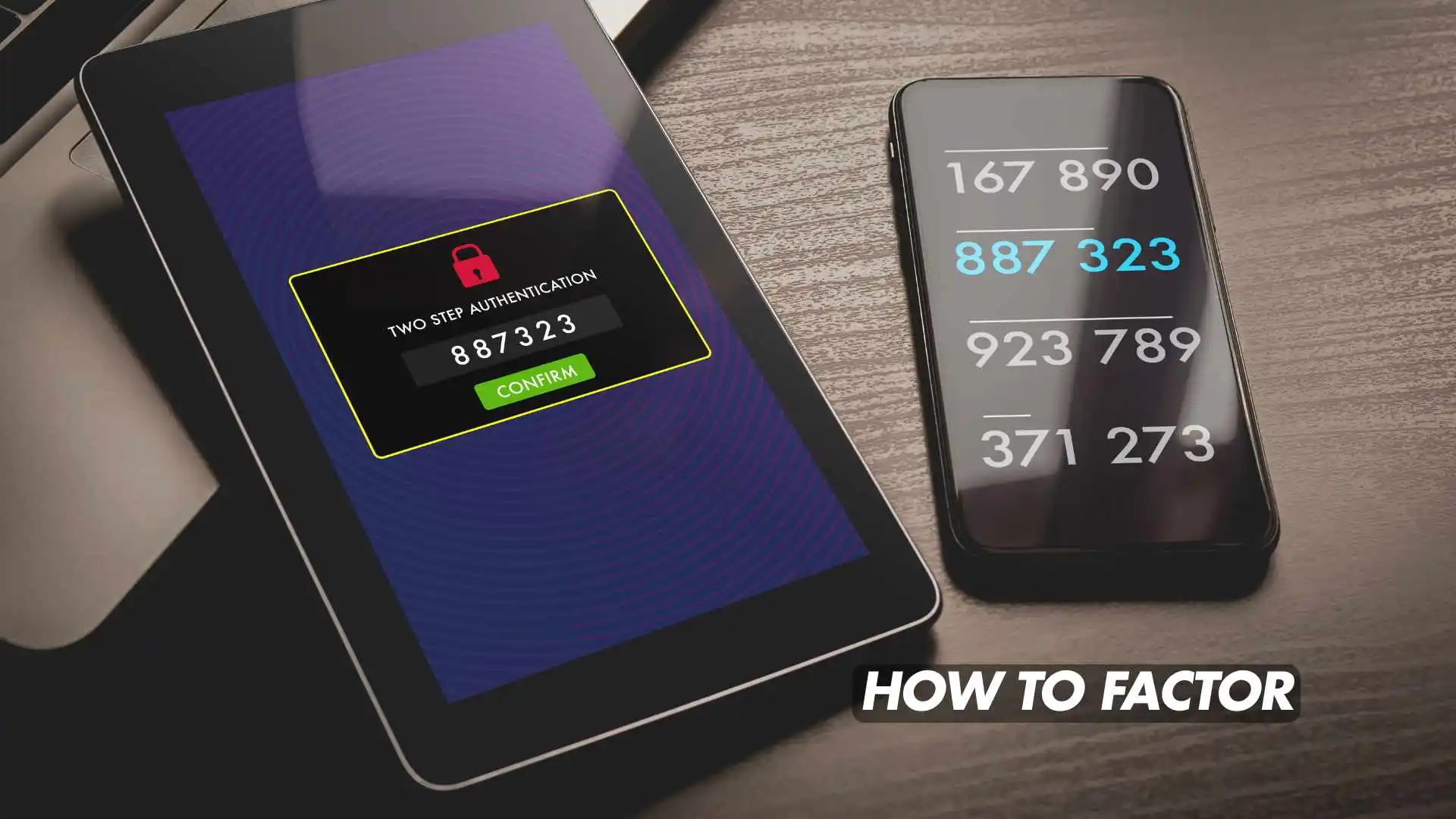Have you ever stared at an algebra problem wondering how to simplify it? Maybe you’ve seen something like x² + 5x + 6 and thought, “Where do I even start?”
Here’s the secret: it all begins with factoring — the process of breaking an expression into simpler, multiplied parts.
Understanding how to factor is like unlocking a universal tool in mathematics. It helps you solve equations, simplify expressions, and uncover patterns that make complex problems easy.
In this detailed step-by-step factoring guide, we’ll explore everything from prime factorization to factoring quadratic equations, with plenty of examples and explanations designed to boost your understanding and your Google ranking if you’re writing for SEO.
What Is Factoring in Math?

Factoring is the process of expressing a number or algebraic expression as a product of its simplest parts, called factors.
In simpler terms, factoring reverses multiplication.
| Example | Factored Form |
| 12 | 2 × 2 × 3 = 2² × 3 |
| x² – 9 | (x – 3)(x + 3) |
In algebra, factoring helps you simplify equations, find roots, and even solve real-world problems.
Why Learning How to Factor Matters
Factoring is the foundation of algebra and beyond. Here’s why it’s essential:
- 🔹 Simplifies Complex Equations – Understanding how to factor equations helps reduce complicated problems into simple forms.
- 🔹 Solves Quadratic and Polynomial Equations – Factoring quadratic equations is one of the most efficient methods to find roots.
- 🔹 Supports Advanced Topics – You’ll need factoring in calculus, geometry, and statistics.
- 🔹 Real-Life Relevance – Used in engineering, finance, physics, and even cryptography.
🧩 Part 1: How to Factor Numbers (Prime Factorization Method)

Before jumping into algebra, let’s start with the basics: factoring numbers using the prime factorization method.
🔢 Step-by-Step Factoring Guide
- Identify Prime Numbers
Prime numbers are divisible only by 1 and themselves (2, 3, 5, 7, 11, etc.). - Divide by the Smallest Prime
Keep dividing until you reach 1.
Example 1: Factor 60
| Step | Division | Result |
| 1 | 60 ÷ 2 | 30 |
| 2 | 30 ÷ 2 | 15 |
| 3 | 15 ÷ 3 | 5 |
| 4 | 5 ÷ 5 | 1 |
✅ Prime Factorization = 2 × 2 × 3 × 5 = 2² × 3 × 5
Example 2: Factor 84
| Step | Division | Result |
| 1 | 84 ÷ 2 | 42 |
| 2 | 42 ÷ 2 | 21 |
| 3 | 21 ÷ 3 | 7 |
✅ Prime Factors = 2² × 3 × 7
🧮 Part 2: How to Factor Algebraic Expressions

Now that you know how to factor numbers, let’s move on to factoring in algebra — where the real fun begins.
There are several factoring techniques in algebra that you’ll use depending on the type of equation.
1. Factoring Out the Greatest Common Factor (GCF)
Definition: The GCF is the largest factor common to all terms in an expression.
Example:
Factor 6x² + 9x
- Coefficient GCF = 3
- Variable GCF = x
- Factor out 3x
✅ 6x² + 9x = 3x(2x + 3)
This is the first step in nearly all factoring equations step by step.
2. Factoring by Grouping
Used when you have four terms in a polynomial.
Example:
Factor x³ + 3x² + 2x + 6
- Group: (x³ + 3x²) + (2x + 6)
- Factor each: x²(x + 3) + 2(x + 3)
- Factor out common term:
✅ (x + 3)(x² + 2)
This factoring by grouping method is key for factoring polynomials.
3. Factoring Trinomials
A trinomial is an expression with three terms (ax² + bx + c).
Case 1: When a = 1
Example: x² + 5x + 6
We need two numbers that multiply to 6 and add to 5 → (2, 3).
✅ x² + 5x + 6 = (x + 2)(x + 3)
Case 2: When a ≠ 1
Example: 2x² + 7x + 3
- Multiply a × c = 6
- Numbers that multiply to 6 and add to 7 → (6, 1)
- Rewrite: 2x² + 6x + x + 3
- Group: (2x² + 6x) + (x + 3)
- Factor: 2x(x + 3) + 1(x + 3)
✅ (2x + 1)(x + 3)
This is the standard factoring quadratic equations process.
4. Factoring Perfect Squares
Formula:
a² + 2ab + b² = (a + b)²
Example:
x² + 6x + 9 → (x + 3)²
✅ Perfect Square Factored Form = (x + 3)²
5. Factoring the Difference of Squares
Formula:
a² – b² = (a + b)(a – b)
Example:
x² – 16 → (x + 4)(x – 4)
This difference of squares factoring trick is quick and powerful.
6. Factoring the Sum and Difference of Cubes
Formulas:
- a³ + b³ = (a + b)(a² – ab + b²)
- a³ – b³ = (a – b)(a² + ab + b²)
Example 1:
x³ + 27 = (x + 3)(x² – 3x + 9)
Example 2:
x³ – 8 = (x – 2)(x² + 2x + 4)
7. Factoring Using the Factor Theorem
If substituting x = a makes a polynomial zero, then (x – a) is a factor.
Example:
Factor x³ – 6x² + 11x – 6
- Test x = 1 → 1 – 6 + 11 – 6 = 0 ✅
- Divide by (x – 1): x² – 5x + 6
- Factor further: (x – 2)(x – 3)
✅ Final: (x – 1)(x – 2)(x – 3)
This method is the foundation of factoring polynomials efficiently.
💡 Common Factoring Formulas (Quick Reference Table)
| Formula Type | Expression | Factored Form |
| Difference of Squares | a² – b² | (a + b)(a – b) |
| Perfect Square | a² + 2ab + b² | (a + b)² |
| Sum of Cubes | a³ + b³ | (a + b)(a² – ab + b²) |
| Difference of Cubes | a³ – b³ | (a – b)(a² + ab + b²) |
🌍 Real-World Applications of Factoring
Factoring isn’t just academic — it’s practical:
- Engineering: Simplifies formulas in mechanics and design.
- Finance: Used to factor interest rate equations.
- Physics: Breaks down complex motion equations.
- Computer Science: Prime factorization is the backbone of encryption.
Example:
In cryptography, the security of RSA encryption depends on how difficult it is to factor large numbers — proving that this concept is powerful in real-world tech.
⚙️ Common Mistakes (and How to Avoid Them)
| Mistake | Why It Happens | Fix |
| Forgetting to factor out the GCF | Skipping first step | Always look for the GCF first |
| Sign errors (+/– confusion) | Rushing through terms | Double-check before finalizing |
| Expanding incorrectly | Not verifying results | Always multiply back to verify |
| Misidentifying perfect squares | Confusing coefficients | Check middle term (2ab rule) |
🚀 How to Improve Your Factoring Skills
- Practice daily – Solve 5–10 factoring problems each day.
- Memorize key patterns – Perfect squares, cubes, and trinomials.
- Check by expansion – Always confirm by multiplying back.
- Use visual aids – Draw factor trees and grids.
- Use learning tools – Try Khan Academy or Symbolab for guided practice.
❓ Frequently Asked Questions (FAQs)
Q1: What is factoring in algebra?
It’s the process of breaking down expressions into simpler parts that multiply to form the original equation.
Q2: What’s the easiest way to learn how to factor?
Start with factoring numbers, then move to algebraic expressions. Always identify the GCF first.
Q3: Can every polynomial be factored?
No. Some are prime polynomials and can’t be factored over real numbers.
Q4: What is the prime factorization method used for?
It’s used to express numbers as a product of prime factors — crucial for cryptography and number theory.
Q5: How do you check your factoring answer?
Simply multiply the factors back together. If you get the original expression, your factorization is correct.
🏁 Conclusion:
Factoring is the language of algebra — a skill that transforms complex problems into simple patterns.
From prime factorization to factoring quadratic equations, every method follows logical steps that anyone can learn.
When you master how to factor step by step, you’re not just solving math problems — you’re training your brain to think critically and solve challenges efficiently.



